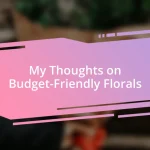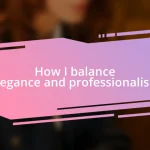Key takeaways:
- Choosing flowers that resonate with the theme and season enhances emotional expression in arrangements, creating memorable experiences.
- Understanding color theory is essential; different colors evoke specific emotions, influencing the ambiance of events.
- Finalizing floral presentations with careful attention to details and complementary elements can elevate the overall impact and storytelling of the arrangement.

Choosing the right flowers
Choosing the right flowers can feel like an art form. I still remember the first time I was tasked with creating a centerpiece for a summer wedding. The couple wanted something bright and cheerful, so I decided on sunflowers and daisies. Their vibrant colors echoed the couple’s youthful love, and the expressions on their faces when they saw the arrangements were priceless.
When selecting flowers, it’s essential to consider the theme and emotion you want to convey. For instance, if you’re aiming for a romantic atmosphere, delicate peonies and soft pastel roses might do the trick. Have you ever walked into a room filled with flowers that just took your breath away? That’s the power of carefully choosing blooms that resonate with the theme.
Don’t forget about seasonality! Using flowers that are in bloom during your event will not only enhance freshness but also align with the natural beauty of the season. I once opted for autumn-colored flowers for a fall gathering, incorporating deep reds and oranges that reflected the turning leaves outside. It created a warm, inviting atmosphere that guests couldn’t help but admire.

Understanding color theory
Understanding color theory plays a crucial role in floral arrangement. I remember the excitement I felt when I first discovered how colors can evoke specific emotions. For example, the soft yellows and greens can create a feeling of tranquility and peace, ideal for a spring gathering. In contrast, vibrant reds and oranges bring energy and passion, perfect for a celebration.
Each color can tell a story. When I was asked to create arrangements for a baby shower, I carefully selected soft blues and gentle pinks. This combination wasn’t just visually appealing; it resonated deeply with everyone present, capturing the nurturing essence of new life. I often reflect on how even the smallest details, like color choices, can profoundly influence the ambiance and mood of an event.
Using the color wheel is an excellent way to understand these relationships. Complementary colors, those opposite each other on the wheel, create striking visual contrasts that can be very effective in floral designs. For my sister’s wedding, I paired deep purples with bright yellows, and the results were stunning! The arrangement felt lively and festive, perfectly matching the joyous occasion.
| Color Type | Emotion/Effect |
|---|---|
| Warm Colors (Red, Orange, Yellow) | Energy, Passion, Happiness |
| Cool Colors (Blue, Green, Purple) | Calmness, Serenity, Sophistication |

Incorporating seasonal blooms
Incorporating seasonal blooms brings a unique charm to any floral arrangement. I recall a spring garden party where I handpicked vibrant tulips and cheerful daffodils. The guests were instantly transported by the fresh, lively scents and colors, and it made the atmosphere feel full of life and renewal. Seasonal flowers not only look beautiful, but they also celebrate the time of year, deepening the connection between the event and the natural world.
When planning your arrangements, consider these seasonal favorites:
- Spring: Tulips, daffodils, hyacinths
- Summer: Sunflowers, zinnias, dahlias
- Autumn: Mums, pumpkins, asters
- Winter: Amaryllis, poinsettias, evergreen foliage
By thoughtfully choosing flowers that align with the season, you create an authentic and immersive experience that resonates with everyone present.

Using flowers for symbolism
Using flowers for symbolism adds a profound layer of meaning to any arrangement. I’ve often found that each flower carries its unique significance; for instance, roses symbolize love, while lilies often represent purity. During my friend’s engagement party, I opted for white roses to convey their blossoming love, wrapping the event in a poignant gesture that resonated deeply with the couple and their guests.
I remember a time when I arranged flowers for a memorial service. In those challenging moments, I chose chrysanthemums, a flower that signifies honor and respect in many cultures. The atmosphere shifted as people arrived, finding solace in the vibrant blooms that celebrated a life lived fully. Isn’t it remarkable how a simple flower can stir emotions and anchor us in our shared experiences?
Sometimes, I think about how a single daisy can symbolize innocence and new beginnings. When I created a bouquet for a friend’s first child’s birthday, I included daisies alongside more vibrant flowers. This isn’t just about decoration but illustrating the journey of growth and joy through the years, sparking conversations and shared memories among family and friends. What better way to honor our feelings than through the beauty of flowers?

Selecting complementary elements
When I think about selecting complementary elements for my floral arrangements, I often consider the colors, textures, and shapes around the blooms. For example, I once crafted a mesmerizing centerpiece using bold orange lilies, and to enhance their beauty, I added delicate white lace accents and dark green foliage. The contrast not only highlighted the flowers’ vibrancy but also created a sense of depth that drew everyone’s attention—it’s such a joy to see guests mesmerized by the details!
Textured elements can elevate an arrangement beyond mere aesthetics. I remember when I decided to pair soft, fluffy pampas grass with sleek, modern roses for a friend’s modern wedding. The contrast created a beautiful harmony that complemented both the venue’s decor and the couple’s style. It was fascinating to witness how these contrasting elements blended seamlessly to tell a story of unity and modern elegance.
Another critical aspect is the mood you wish to evoke. I’ve learned that soft pastels can create a gentle, calming atmosphere, while vibrant hues often spark energy and excitement. During a vibrant summer festival, I created arrangements bursting with bright sunflowers and cheerful daisies, and the reactions from attendees were simply electric! Isn’t it incredible how the right combination of elements can turn a simple gathering into a memorable experience?

Arranging flowers for impact
When it comes to arranging flowers for impact, I’ve discovered that placement truly makes all the difference. One particular arrangement that stands out for me was a display I created for a friend’s milestone birthday; I elevated the larger blooms, like peonies, to draw the eye upward and create a focal point. The joy on her face as she walked into the room and gasped at the vibrant blossoms was priceless. Isn’t it delightful how strategic positioning can change the energy of a space?
In my experience, creating layered heights not only adds depth but also invites curiosity. I vividly recall a corporate event where I used varying heights of glass vases filled with different blooms, like snapdragons and hydrangeas. The layers beckoned attendees to explore each arrangement, allowing the flowers to become conversation starters. It’s fascinating how a thoughtfully arranged display can foster connections among guests, wouldn’t you agree?
Finally, I believe that a cohesive theme enhances overall impact. When tasked with arranging flowers for a rustic wedding, I chose sunflowers and wildflowers, integrating elements of the venue into my design. The results were visually stunning and deeply resonant with the couple’s story, reinforcing their love for nature. I find myself continually amazed at how flower arrangements can transcend mere decoration to embody emotions and narratives.

Finalizing the floral presentation
Once the arrangement is in place, I focus on the finer details to finalize the floral presentation. I remember a charity gala where I added touches like twinkling fairy lights woven through the flowers. The soft glow created an enchanting atmosphere, making the entire display feel alive. Have you ever noticed how some little tweaks can elevate a whole presentation?
Next, I consider the finishing touches that tie the whole theme together. For instance, during a beach-themed wedding, I incorporated seashells alongside my vibrant tropical flowers. It wasn’t just about visual appeal; it evoked a sense of place that resonated with the couple’s love for the ocean. Moments like that remind me of the power of storytelling through floral design.
Lastly, I often step back for a moment of reflection. After completing an arrangement, I take the time to assess how it feels as a whole. When I did a winter arrangement filled with icy blue hues and delicate silver accents, I felt a sense of calm wash over me. It’s in these moments that I realize the emotional connection we can forge through our floral creations. How do you want your guests to feel when they encounter your arrangements?














